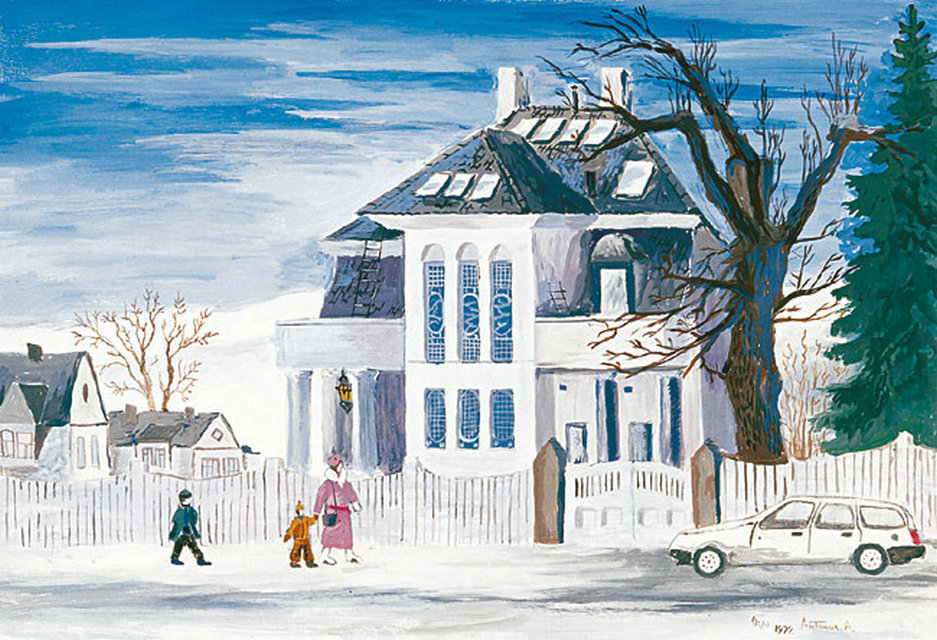The International Museum of Children´s Art (Det internasjonale barnekunstmuseet) in Oslo, Norway is a pioneer institution, being the world´s first full scale Museum of Child Art. Today, the museum´s art collection contains art works by children and young from more than 180 countries.
The Museum was established in 1986 by The Foundation of Children’s History, Art and Culture. Film director Rafael Goldin (1920-1994) and his wife, Doctor of Medicine, Alla Goldin (1938-2007), have conceived and developed the idea of this unique Museum and collection.
At Lille Frøens vei in Oslo you can see the world through children’s eyes and understand how children’s art is a bearer of esthetical values. The Museum regards children’s art as a living part of folk art and also as an important element in our national and universal culture. The children’s own opinion and concerns are presented through changing thematic exhibitions, carefully chosen with the same demands for quality as in an adults art museum.
Soviet film artist Rafael Goldin (1920-1994) came to Norway in 1973 and began working on children’s art after a divorce where he lost contact with his son. In 1978 he married the doctor Alla Goldin (1938-2007), also originally from the Soviet Union, and together they established in 1980 the Children’s, History, Arts and Culture Foundation. When the founder of SOS Children’s Villages, Hermann Gmeiner in 1986 donated 600,000 kroner to the foundation from his own pocket, they could buy a villa at Frøen in Oslo and the museum was opened by Prime Minister Gro Harlem Brundtland on October 1, 1986.
However, the villa quickly became too small for the growing collection. In 1992 there were concrete plans to expand the building by 600 to 700 square meters below ground, but plans were suspended by the Winner district committee following powerful neighbor protests. Today the museum is looking for a new building in Bjørvika.
During the period 2009-2011 the museum’s permanent image collection was photographed and cataloged with project support from Eckbo’s legends.
Since All Gold’s death in 2007, the museum has been led by her daughter, Angela Goldin (1968-). In 2013 she joined Jacob Lund as new chairman.
Collection:
The collection dates from the 1970s to today, and houses between 150,000 and 200,000 objects created by children from over 180 countries. Besides pictures, the collection also contains ceramics, textiles, sculptures, books, and more. The museum has permanent exhibitions of children’s drawings from many countries and a separate activity room where children can draw and create their own art.
FUNCTIONS & VALUES
The main goal is to promote «the Rights of the Child» and in the future also serve as a research centre for the study of the history, art and culture of the child. The museum is beneficial to children as well as to adults and the collection is intended as a source of inspiration to both children and adults – including artists, pedagogues, researchers and politicians. Our longterm efforts are to develop appreciation of the value of children’s art and culture represent, at the same time, a struggle to protect the rights of the child. The right to have and preserve a culture of one’s own is an accepted principle, when referring to nations or segments of the population. In addition to aesthetic qualities, the Museum contributes to provide a better understanding of children’s visions and standards of value.
It is said that children are people. But, people do not exist without a culture. Children are people who belong to the future. And they have the right to their own culture, their own art and history – Founder & Film director Rafael Goldin (1920-1994)
THE 3 BASIC FUNCTIONS OF THE MUSEUM
PRESERVATION:
We collect children’s art from all over the world and perserve it for the future.
CREATION:
Children and adults visiting the Museum will be able to participate in activities: music, singing and painting- activities outdoors during the summerperiod.
PRESENTATION:
The Museum will arrange travelling exhibitions on different subjects both at home and abroad. Exhibitions can be sent to school, art associations, firms and other organizations. National and international competitions will be arranged,which will cultimate in a traditional annual exhibition.
THE BASIC FUNCTIONS OF THE MUSEUM
PRESERVATION: We collect children’s art from all over the world and preserve it for the future.
CREATION: Children and adults visiting the Museum will be able to participate in activities: music, singing and painting- activities outdoors during the summer period.
PRESENTATION: The Museum will arrange traveling exhibitions on different subjects both at home and abroad.
Exhibitions can be sent to schools, art associations, firms and other organizations. National and international competitions will be arranged, which will cultimate in a traditional annual exhibition. The Museum publishes reproductions of children’s pictures, magazines, children’s art catalogs and books on various subjects.
The main goal is to promote «the Rights of the Child» and in the future also serve as a research center for the study of the history, art and culture of the child. The museum is beneficial to children as well as to adults and the collection is intended as a source of inspiration to both children and adults – including artists, pedagogues, researchers and politicians. Our long-term efforts are to develop appreciation of the value of children’s art and culture represent, at the same time, a struggle to protect the rights of the child. The right to have and preserve a culture of one’s own is an accepted principle, when referring to nations or segments of the population. In addition to aesthetic qualities, the Museum contributes to provide a better understanding of children’s visions and standards of value.
MUSEUM STRUCTURE
The museum is owned by the private Foundation of Children’s History, Art and Culture, which was established in 1980. It is governed by a board of members and the museum is a member of the Association of Norwegian Museums of Art and Social History, and UNESCO’s International Society of Museums. The museum receives annual grant from the Norwegian Ministry of Culture.
